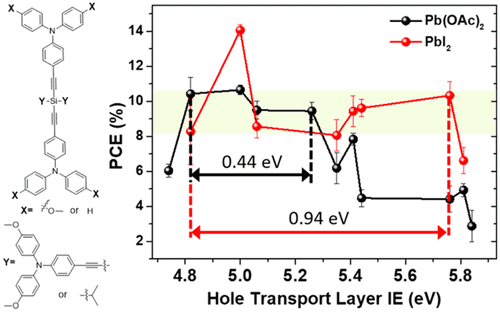当前位置:
X-MOL 学术
›
ACS Appl. Mater. Interfaces
›
论文详情
Our official English website, www.x-mol.net, welcomes your
feedback! (Note: you will need to create a separate account there.)
Processing Dependent Influence of the Hole Transport Layer Ionization Energy on Methylammonium Lead Iodide Perovskite Photovoltaics
ACS Applied Materials & Interfaces ( IF 8.3 ) Pub Date : 2018-04-19 00:00:00 , DOI: 10.1021/acsami.7b16894 So Min Park , Samuel M. Mazza , Zhiming Liang , Ashkan Abtahi , Alex M. Boehm , Sean R. Parkin , John E. Anthony , Kenneth R. Graham
ACS Applied Materials & Interfaces ( IF 8.3 ) Pub Date : 2018-04-19 00:00:00 , DOI: 10.1021/acsami.7b16894 So Min Park , Samuel M. Mazza , Zhiming Liang , Ashkan Abtahi , Alex M. Boehm , Sean R. Parkin , John E. Anthony , Kenneth R. Graham

|
Organometal halide perovskite photovoltaics typically contain both electron and hole transport layers, both of which influence charge extraction and recombination. The ionization energy (IE) of the hole transport layer (HTL) is one important material property that will influence the open-circuit voltage, fill factor, and short-circuit current. Herein, we introduce a new series of triarylaminoethynylsilanes with adjustable IEs as efficient HTL materials for methylammonium lead iodide (MAPbI3) perovskite based photovoltaics. The three triarylaminoethynylsilanes investigated can all be used as HTLs to yield PV performance on par with the commonly used HTLs PEDOT:PSS and Spiro-OMeTAD in inverted architectures (i.e., HTL deposited prior to the perovskite layer). We further investigate the influence of the HTL IE on the photovoltaic performance of MAPbI3 based inverted devices using two different MAPbI3 processing methods with a series of 11 different HTL materials, with IEs ranging from 4.74 to 5.84 eV. The requirements for the HTL IE change based on whether MAPbI3 is formed from lead acetate, Pb(OAc)2, or PbI2 as the Pb source. The ideal HTL IE range is between 4.8 and 5.3 eV for MAPbI3 processed from Pb(OAc)2, while with PbI2 the PV performance is relatively insensitive to variations in the HTL IE between 4.8 and 5.8 eV. Our results suggest that contradictory findings in the literature on the effect of the HTL IE in perovskite photovoltaics stem partly from the different processing methods employed.
中文翻译:

空穴传输层电离能对甲基铵碘化铅钙钛矿光伏的加工依赖性影响
有机金属卤化物钙钛矿光伏电池通常包含电子传输层和空穴传输层,这两者都会影响电荷的提取和复合。空穴传输层(HTL)的电离能(IE)是一种重要的材料特性,它将影响开路电压,填充系数和短路电流。本文中,我们介绍了一系列具有可调IE的三芳基氨基乙炔基硅烷,作为用于甲基铵碘化铅(MAPbI 3)的有效HTL材料。)钙钛矿型光伏电池。所研究的三种三芳基氨基乙炔基硅烷都可以用作HTL,以产生与反向结构中常用的HTL PEDOT:PSS和Spiro-OMeTAD相同的PV性能(即,在钙钛矿层之前沉积的HTL)。我们进一步研究了HTL IE对基于MAPbI 3的倒置器件的光伏性能的影响,该器件使用两种不同的MAPbI 3处理方法以及一系列11种不同的HTL材料,IE的范围为4.74至5.84 eV。对HTL IE的要求会根据MAPbI 3是由醋酸铅,Pb(OAc)2还是PbI 2作为Pb源形成而变化。对于MAPbI,理想的HTL IE范围在4.8至5.3 eV之间3由Pb(OAc)2处理而成,而使用PbI 2时,PV性能对HTL IE在4.8和5.8 eV之间的变化相对不敏感。我们的结果表明,文献中有关钙钛矿型光伏电池中HTL IE影响的矛盾发现部分源于所采用的不同处理方法。
更新日期:2018-04-19
中文翻译:

空穴传输层电离能对甲基铵碘化铅钙钛矿光伏的加工依赖性影响
有机金属卤化物钙钛矿光伏电池通常包含电子传输层和空穴传输层,这两者都会影响电荷的提取和复合。空穴传输层(HTL)的电离能(IE)是一种重要的材料特性,它将影响开路电压,填充系数和短路电流。本文中,我们介绍了一系列具有可调IE的三芳基氨基乙炔基硅烷,作为用于甲基铵碘化铅(MAPbI 3)的有效HTL材料。)钙钛矿型光伏电池。所研究的三种三芳基氨基乙炔基硅烷都可以用作HTL,以产生与反向结构中常用的HTL PEDOT:PSS和Spiro-OMeTAD相同的PV性能(即,在钙钛矿层之前沉积的HTL)。我们进一步研究了HTL IE对基于MAPbI 3的倒置器件的光伏性能的影响,该器件使用两种不同的MAPbI 3处理方法以及一系列11种不同的HTL材料,IE的范围为4.74至5.84 eV。对HTL IE的要求会根据MAPbI 3是由醋酸铅,Pb(OAc)2还是PbI 2作为Pb源形成而变化。对于MAPbI,理想的HTL IE范围在4.8至5.3 eV之间3由Pb(OAc)2处理而成,而使用PbI 2时,PV性能对HTL IE在4.8和5.8 eV之间的变化相对不敏感。我们的结果表明,文献中有关钙钛矿型光伏电池中HTL IE影响的矛盾发现部分源于所采用的不同处理方法。











































 京公网安备 11010802027423号
京公网安备 11010802027423号